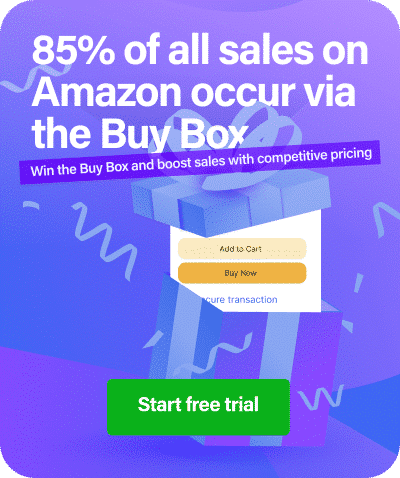How does Amazon dynamic pricing increase sales, and why is it essential for sellers? Because (in short) it helps you stay competitive, win the Buy Box, and boost revenue by automatically adjusting prices based on market conditions. A strong dynamic pricing strategy means you never miss opportunities to capture demand while protecting margins.
What is Amazon Dynamic Pricing?
Amazon dynamic pricing is the practice of automatically adjusting product prices in response to changing market factors (like market demand, competition, inventory levels, and customer behavior). But unlike manual updates, it uses data-driven rules to optimize prices in real time (and it’s much quicker, less prone to errors, and more comprehensive).
All in all, it’s good news.
For more information on this (and decide whether it’s right for you), take a look at our guide to mastering Amazon dynamic pricing.
Why Dynamic Pricing Increases Amazon Sales
Dynamic pricing works because it aligns product pricing with customer demand and competitor behavior. The right adjustments improve visibility, raise sales velocity, and increase your chances of winning the Buy Box.
Key Drivers of Increased Sales:
- Faster response to competitor price changes
- Improved positioning in Amazon search results
- Stronger alignment with customer buying patterns
What are the Key Benefits of a Dynamic Pricing Strategy?
A well-structured Amazon pricing strategy delivers measurable advantages:
- Higher Buy Box win rates
- Increased profit margins without sacrificing volume
- Better promotional pricing opportunities
- Long-term sales growth through consistent optimization
For a comparison of approaches (that will help you decide which to take), here’s some more in-depth information.
How Algorithmic Pricing Tools Drive Results
Algorithmic pricing tools use advanced logic to monitor the market and automatically adjust prices in real time. Instead of relying on manual updates, which can take hours or even days, these tools analyze competitor activity, demand fluctuations, and Buy Box eligibility factors to react within seconds.
This saves time, reduces guesswork, and makes sure your listings stay competitive 24/7. More importantly, it allows sellers to focus on scaling their business rather than constantly checking prices.
Key advantages of using algorithmic pricing tools include:
- Speed and Accuracy: Adjustments happen instantly, keeping you competitive without manual intervention.
- Data-Driven Decisions: Tools analyze price elasticity, sales velocity, and competitor analysis to determine the optimal price point.
- Consistency: Pricing rules ensure you never drop below your minimum profit margin while still pursuing the Buy Box.
- Scalability: As your catalog grows, algorithmic pricing tools handle thousands of listings effortlessly.
For clarity, here’s a practical example of this in action:
If a competitor drops their price by $0.50 on a high-volume product, an algorithmic tool can immediately adjust your price to remain competitive without sacrificing profitability. By contrast, a manual approach may miss the opportunity and risk losing Buy Box share.
Understanding Price Elasticity and Sales Velocity
Dynamic pricing strategies rely on measuring price elasticity, which helps sellers understand how customers respond to price changes. Coupled with sales velocity data, sellers can predict the ideal pricing point for maximum conversions.
For beginners, here’s an introduction to Amazon pricing strategies.
Competitor Analysis and the Buy Box Algorithm
To succeed on Amazon, sellers must consider their competitors’ pricing, as well as play smart with the Buy Box algorithm. The algorithm uses factors like shipping times, seller ratings, and fulfillment methods (along with pricing) to determine who wins.
Learn more about the Buy Box algorithm.
Practical Steps to Get Started with Dynamic Pricing
This doesn’t have to be complicated – far from it.
It simply involves:
- Choosing the right repricing software
- Defining minimum and maximum price ranges
- Setting automated rules based on competitor analysis
- Monitoring results and adjusting strategies regularly
FAQs
What is the difference between dynamic pricing and repricing?
Dynamic pricing is a broad strategy to adjust prices based on demand and market conditions, while repricing focuses specifically on competitive pricing for platforms like Amazon.
Can dynamic pricing hurt profit margins?
Not if managed correctly. By setting floor and ceiling prices, sellers make sure they remain profitable and still competitive.
Do all sellers need repricing software?
For sellers with more than a few listings, repricing software is almost essential (and we’re not just saying that). It saves time, reduces errors, and makes sure all your listings are competitive (and therefore effective).
Key Takeaways and Next Steps
Dynamic pricing is a proven way to increase sales, protect margins, and capture market share. By using algorithmic pricing tools, monitoring price elasticity, and aligning with the Buy Box algorithm, sellers can maximize results – and profits.
Ready to see how Repricer can help? Book a Demo today and unlock the power of Amazon dynamic pricing.





